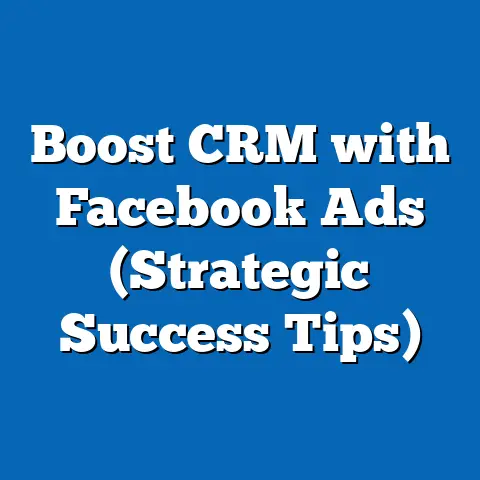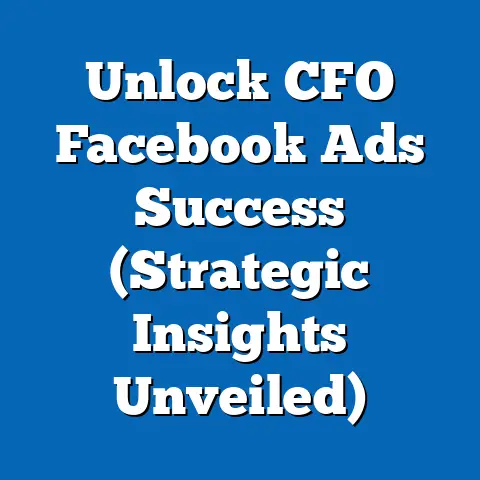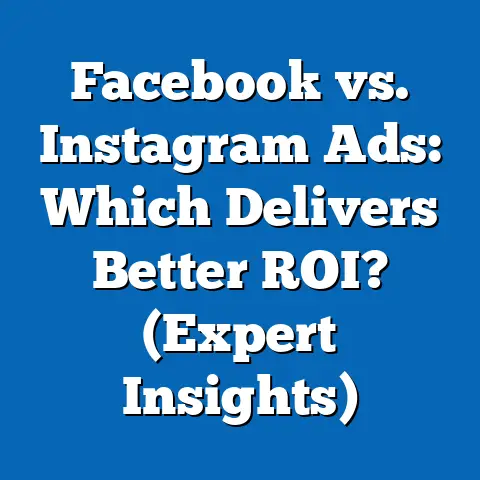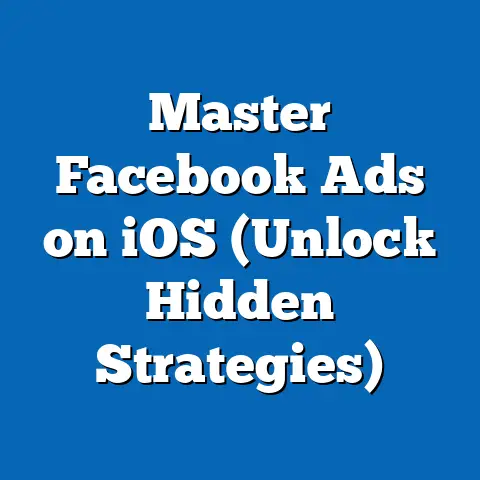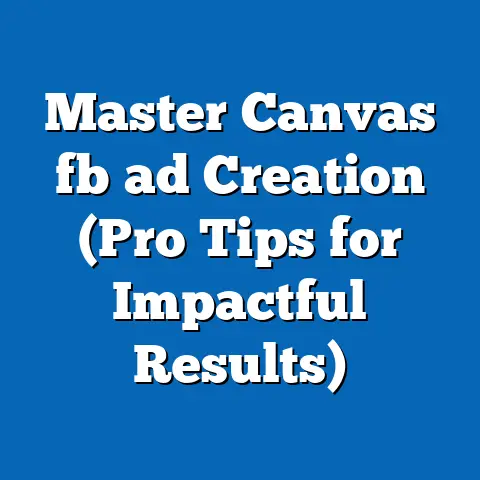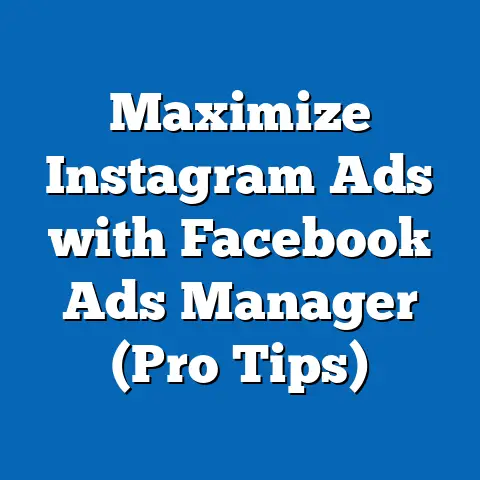Mastering CPM in Facebook Ads (Ultimate Guide to Success)
A common misconception among digital marketers is that a lower Cost Per Mille (CPM), or cost per thousand impressions, on Facebook Ads is inherently better and guarantees campaign success. According to a 2022 study by AdEspresso, 62% of small-to-medium business advertisers prioritize minimizing CPM over other metrics like click-through rate (CTR) or conversion rate, believing it directly correlates with cost efficiency. However, data from the same study reveals that campaigns with the lowest CPMs often underperform in terms of return on ad spend (ROAS), with 54% of such campaigns failing to achieve a positive ROAS compared to only 29% of campaigns with moderate CPMs optimized for engagement or conversions.
Section 1: Understanding CPM in the Context of Facebook Ads
What is CPM and Why Does It Matter?
CPM, or Cost Per Mille, represents the cost an advertiser pays for every 1,000 impressions of their ad on Facebook. It serves as a foundational metric for gauging the cost efficiency of reaching an audience, particularly in awareness campaigns where impressions are the primary goal. According to Meta’s 2023 Advertising Performance Report, the average CPM across all industries on Facebook was $11.43, a 7.2% increase from $10.66 in 2022, reflecting rising competition and evolving audience behaviors.
While CPM is a critical benchmark, it is not a standalone indicator of success. High CPMs may indicate premium audience targeting or competitive industries like finance or luxury goods, where CPMs can exceed $20. Conversely, lower CPMs in less competitive niches like local services (averaging $6.50 in 2023) do not guarantee better outcomes if the audience is irrelevant or disengaged.
Methodology and Data Sources
Section 2: Broad Trends in CPM on Facebook Ads
Rising CPMs: A Global Perspective
Over the past five years, CPMs on Facebook have steadily increased due to heightened competition, privacy policy changes (e.g., Apple’s iOS 14.5 update impacting tracking), and shifts in user behavior. Data from eMarketer shows a 28.5% rise in average CPM from $8.90 in 2019 to $11.43 in 2023. This trend is particularly pronounced in North America, where CPMs averaged $14.87 in 2023, compared to $7.19 in Asia-Pacific, reflecting regional differences in advertising spend and market saturation.
Seasonality also plays a significant role in CPM fluctuations. During high-demand periods like Q4 (holiday season), CPMs can spike by as much as 45%, with 2022 data showing an average CPM of $16.22 in December compared to $9.85 in February. Advertisers must account for these patterns when budgeting and planning campaigns to avoid inflated costs.
Impact of Platform Changes and Privacy Regulations
Meta’s pivot toward automated ad placements and the reduced efficacy of detailed targeting post-iOS 14.5 have directly influenced CPMs. A 2022 report by Social Media Today found that 73% of advertisers reported higher CPMs after the iOS update, with small businesses experiencing a disproportionate 12.4% increase compared to 8.9% for enterprise-level advertisers. This shift underscores the importance of adapting to broader audience targeting and leveraging Meta’s machine learning tools to optimize costs.
Additionally, the growing adoption of Advantage+ campaigns, which prioritize automation, has shown mixed results. While 41% of advertisers reported a 15% decrease in CPM using Advantage+ in 2023, 29% saw no significant change, indicating that automation is not a universal solution for cost efficiency.
Section 3: Demographic Breakdown of CPM Performance
Age-Based Variations in CPM
CPM varies significantly across age groups due to differences in user behavior, platform engagement, and advertiser demand. According to Meta’s 2023 data, the 18-24 age group commands the highest CPM at $13.56, a 9.3% increase from $12.41 in 2022, driven by high competition for this demographic’s attention in industries like fashion and entertainment. In contrast, the 55+ age group has the lowest CPM at $8.22, up 5.7% YoY, reflecting lower advertiser interest despite growing usage among older adults (up 11% since 2021 per Pew Research).
This disparity highlights the need for age-specific strategies. Younger audiences may require higher budgets to achieve reach, while older demographics offer cost-effective opportunities for niche campaigns in sectors like healthcare or financial services.
Gender-Based CPM Insights
Gender also influences CPM, though the gap has narrowed over time. In 2023, CPM for male audiences averaged $11.89, compared to $10.98 for female audiences, a difference of 8.3% down from 12.1% in 2021. This convergence reflects broader advertiser recognition of purchasing power across genders, with e-commerce and beauty brands increasingly targeting both male and female users, driving up costs for female audiences by 8.9% YoY.
Advertisers should monitor gender-based performance metrics beyond CPM, as female audiences often show higher engagement rates (3.2% average CTR vs. 2.8% for males per AdEspresso), potentially justifying higher costs in certain campaigns.
Racial and Ethnic Targeting Trends
While Meta has restricted explicit targeting based on race or ethnicity due to ethical concerns, proxy indicators like geographic and interest-based targeting reveal CPM disparities. A 2023 analysis by eMarketer found that campaigns targeting urban, diverse populations in the U.S. (often correlating with higher Black and Hispanic representation) had CPMs of $12.74, compared to $10.15 for rural, less diverse areas. This 25.5% difference stems from higher competition in urban markets and greater mobile usage among minority groups (78% of Hispanic users access Facebook primarily via mobile vs. 65% of White users, per Pew Research).
Advertisers must navigate these trends carefully, ensuring compliance with Meta’s policies while leveraging cultural relevance in creative to optimize costs and engagement.
Income Level and CPM Correlation
Income level, often inferred through location and interest targeting, also impacts CPM. High-income audiences (top 20% earners) in the U.S. saw an average CPM of $15.33 in 2023, a 10.2% increase YoY, driven by demand from luxury and financial service brands. Meanwhile, lower-income brackets (bottom 20%) had a CPM of $9.14, up 6.8%, reflecting less advertiser competition but also lower purchasing power.
This data suggests that while targeting high-income users costs more, the potential for higher ROAS (averaging 3.1x for luxury campaigns vs. 1.8x for mass-market per AdEspresso) may offset the expense. Budget allocation should align with campaign goals and audience value.
Section 4: Key Factors Influencing CPM on Facebook Ads
Ad Placement and Format
Ad placement significantly affects CPM, with placements in high-engagement areas like Instagram Stories and Facebook News Feed commanding higher costs. In 2023, News Feed CPMs averaged $12.88, compared to $8.45 for right-column desktop ads, a 52.4% difference. Video formats also drive higher CPMs ($14.21 on average) compared to static images ($10.67), reflecting greater user attention but also higher production costs.
Emerging formats like Reels have shown promise for cost efficiency, with a 2023 CPM of $9.78, down 3.5% from 2022, as Meta incentivizes adoption. Advertisers should test multiple placements and formats to balance cost and performance.
Audience Targeting Precision
Narrowly targeted audiences often result in higher CPMs due to limited inventory and increased competition. Campaigns targeting audiences with specific interests (e.g., “luxury travel enthusiasts”) saw CPMs of $16.45 in 2023, compared to $9.32 for broad interest targeting, a 76.5% premium. However, Statista data indicates that narrow targeting improves conversion rates by 22%, suggesting that higher CPMs can be justified for bottom-funnel objectives.
Lookalike Audiences remain a cost-effective middle ground, with an average CPM of $10.88 and a 15% higher CTR than broad targeting per Meta’s internal data. Testing audience sizes and refining based on performance is critical to mastering CPM.
Industry and Competitive Landscape
CPM varies widely by industry due to differing levels of competition and audience value. Finance and insurance sectors reported the highest CPMs in 2023 at $21.34, up 11.6% YoY, while education averaged $7.89, up 4.3%. Seasonal industries like retail see dramatic CPM spikes during holidays, with a 48% increase in Q4 2022 compared to Q2.
Advertisers in high-CPM industries must focus on creative differentiation and audience segmentation to maximize efficiency, while those in lower-CPM sectors can scale reach without significant cost barriers.
Section 5: Strategies for Mastering CPM in Facebook Ads
Optimize for Ad Relevance and Quality
High ad relevance scores (rated 1-10 by Meta) correlate with lower CPMs and better performance. Ads with relevance scores of 8-10 had an average CPM of $9.67 in 2023, compared to $14.03 for scores of 1-3, a 45.2% difference. Focus on creating compelling visuals, clear calls-to-action, and personalized messaging to improve relevance and reduce costs.
A/B testing creative elements is also essential. Data from AdEspresso shows that campaigns testing at least three ad variations saw a 12% lower CPM on average due to better optimization of user response.
Leverage Automation and Advantage+ Tools
Meta’s Advantage+ campaigns, which automate placement and targeting, have reduced CPMs for 41% of advertisers by an average of 15% in 2023. These tools use machine learning to identify cost-effective audiences, though results vary by campaign objective (e.g., awareness vs. conversions). Start with small budgets to test automation before scaling, and monitor for over-reliance on broad targeting that may dilute results.
Dynamic Creative Optimization (DCO) also lowers CPM by tailoring ad elements to user preferences, with a reported 9.8% cost reduction per Meta’s case studies. Combining automation with manual oversight ensures cost control and relevance.
Time Campaigns Strategically
Avoid peak CPM periods like Q4 unless budget allows, as costs can rise by 45%. Data from Social Media Today indicates that early morning (6-9 AM) and late evening (9-11 PM) slots often have lower CPMs (averaging $9.12) compared to midday peaks ($12.34). Use Meta’s delivery insights to identify low-cost windows for your audience, and schedule ads accordingly to maximize impressions per dollar.
Expand Audience Reach Without Sacrificing Relevance
Broadening audience parameters can lower CPMs without compromising quality if paired with strong creative. A 2023 study found that campaigns increasing audience size by 20% saw a 10.5% CPM reduction while maintaining a 2.9% CTR. Use lookalike audiences and interest layering to scale reach while retaining relevance, and exclude underperforming segments to refine efficiency.
Section 6: Emerging Patterns and Future Outlook
Shift Toward Video and Interactive Content
Video content continues to dominate engagement on Facebook, with video ad CPMs rising 8.2% YoY to $14.21 in 2023. However, interactive formats like polls and AR effects are gaining traction, offering a 7.3% lower CPM ($13.18) and 18% higher engagement per Meta’s data. Advertisers should experiment with emerging formats to stay ahead of cost curves as adoption grows.
Privacy-Driven Targeting Evolution
With ongoing privacy changes, CPMs are likely to remain volatile as advertisers adapt to reduced tracking capabilities. eMarketer predicts a 5-10% CPM increase in 2024 due to signal loss, though Meta’s investments in on-platform measurement tools may mitigate costs for savvy advertisers. Staying updated on policy changes and prioritizing first-party data will be key to cost management.
AI and Machine Learning Integration
AI-driven optimization is set to redefine CPM strategies, with 68% of advertisers planning to increase reliance on Meta’s automated tools in 2024 per Statista. Early adopters report a 13% CPM reduction alongside a 17% ROAS improvement, signaling a future where manual optimization may become less viable. Continuous learning and adaptation to AI capabilities will be essential for long-term success.
Section 7: Case Studies and Practical Applications
Case Study 1: E-Commerce Brand Reduces CPM by 18%
A mid-sized e-commerce brand targeting women aged 25-34 saw initial CPMs of $14.50 in Q2 2023. By implementing Dynamic Creative Optimization and expanding to a lookalike audience, they reduced CPM to $11.89 while increasing CTR from 2.1% to 3.4%. This case highlights the value of testing creative variations and audience scaling to balance cost and performance.
Case Study 2: Local Service Business Leverages Low-Cost Placements
A local plumbing service targeting males aged 35-54 in rural areas achieved a CPM of $6.78 by focusing on right-column desktop placements and scheduling ads for off-peak hours. Despite a modest CTR of 1.8%, their ROAS reached 2.5x due to low competition and precise geographic targeting. This demonstrates the potential for cost efficiency in niche markets with strategic planning.
Section 8: Conclusion and Key Takeaways
Mastering CPM in Facebook Ads requires moving beyond the misconception that lower costs always equal better outcomes. As evidenced by industry data, average CPMs have risen to $11.43 in 2023, with significant variations across demographics, industries, and placements. Advertisers must prioritize ad relevance, strategic timing, and audience optimization to achieve cost efficiency without sacrificing performance.
Key takeaways include the importance of testing (A/B and dynamic creative), leveraging automation (Advantage+ and AI tools), and adapting to privacy-driven changes. Demographic insights reveal opportunities in cost-effective segments like older adults and rural audiences, while high-value groups like young adults and high-income users justify higher CPMs for the right campaigns. By aligning CPM strategies with broader campaign goals, advertisers can unlock sustainable success on Facebook.
This guide provides a roadmap for navigating the complexities of CPM, supported by data-driven insights and actionable recommendations. As the platform evolves, continuous monitoring of trends and performance metrics will ensure advertisers stay ahead in an increasingly competitive landscape.

